by Buck Robinson CAS
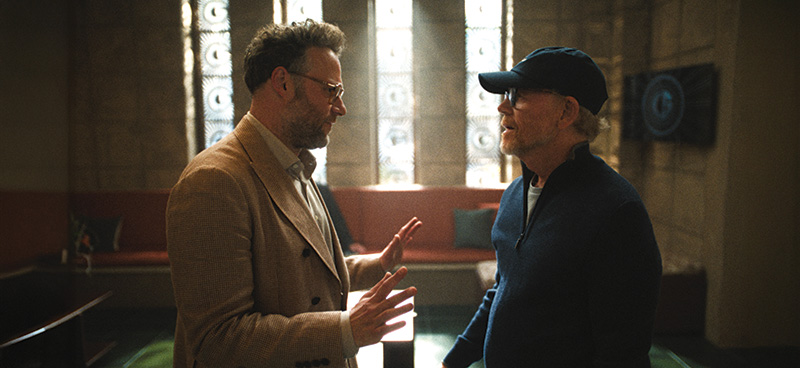
From the get-go, I realized that my job as Production Sound Mixer on Apple TV’s streaming series The Studio was going to have some distinct filmmaking challenges. The technical aspects were many, and I’ll dive into some of those challenges as we go, however, looking back at what we accomplished during Season 1, it struck me that the overwhelming success was due as much to relationships and professional collaboration as it was to technical prowess.
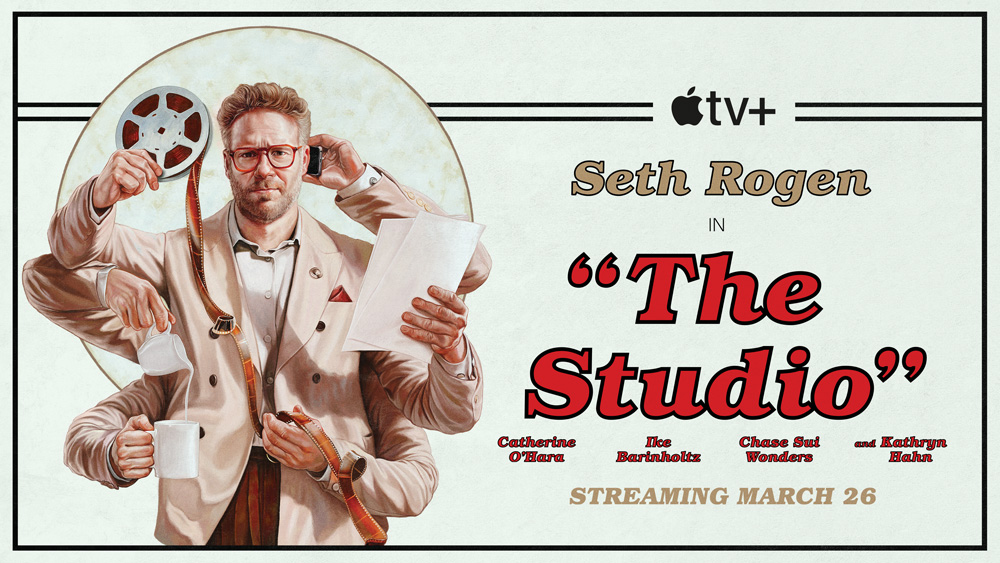
I got a call from UPM/Co-producer Shawn Dyrdahl back in early 2024. He was calling on behalf of Producer Jesse Sternbaum. They were set to do an Apple TV show with Seth Rogen and Evan Goldberg. Jesse and Shawn are longtime friends of mine, and they wanted to get me in for an interview. I had just wrapped three seasons of Physical and Season 1 of Palm Royale with them, among many other shows over the years. They consistently put together some of the finest film crews in Hollywood. I had no doubt I would be surrounded by the best in the business in every department. I was very excited about the opportunity. I wanted in!
I was anxiously optimistic about my interview with Evan and Seth, but having never met them before, I called Jesse for any advice he might have. He replied, “I don’t really think there’s any secret formula. They’re nice guys. Just be yourself and talk to them.”
My Zoom interview was set up for early February of 2024. I got online with Seth, Evan, as well as Producers Pete Huyck, Alex Gregory, and Frida Perez. They explained a bit about the project, concept, shooting style, and pacing. Warner Bros. Studio would be our home and double as our fictitious studio. Then they casually mentioned several world-class Sound Mixers they had previously worked with, so the level of expectation for their sound department was understood. It was a very pleasant, funny conversation. It was also the first of what would become many memorable times I would experience the “Seth Rogen Laugh” in person!
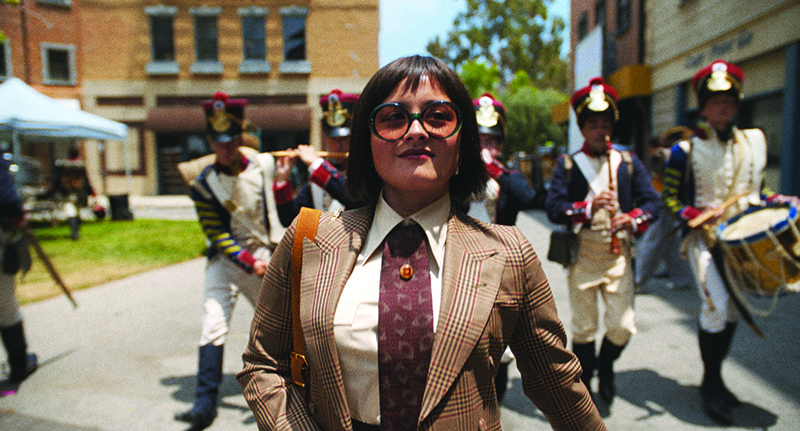
There were only about two real sound-related notes. First, there was not going to be a lot of coverage. A good deal of time we were going to be shooting scenes in single-camera oners. Other times we would shoot multiple cameras simultaneously, but there would be little in the way of traditional “setup by setup” coverage of the scenes. In essence, multi-camera oners.
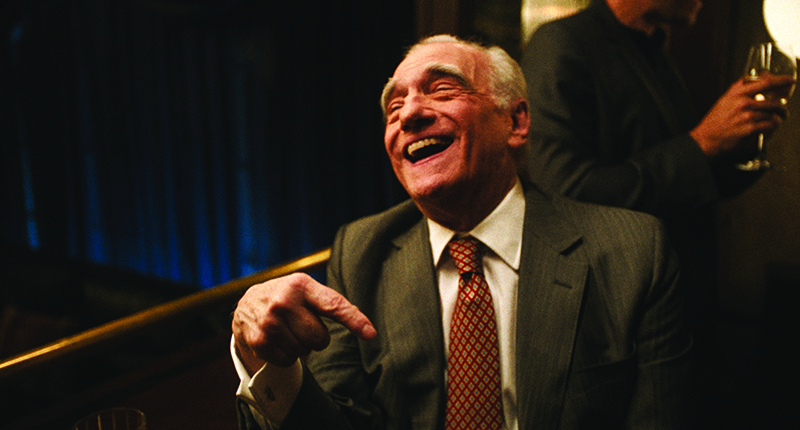
The second note seemed more like an afterthought from Seth, but I realized the importance he placed on it. “I don’t like for an actor to ever get to set ready to shoot and then find out they are in a costume that can’t be wired.” I triple checked that. Years ago on another show, David Fincher once told me, “Buck, it’s really easy. Just do what I tell you to do.” Mental note filed away.
The call was cordial, but I didn’t get a real read on my prospects, one way or the other. Here’s where another established relationship factored in. I decided to touch base with my friend, Cinematographer Brandon Trost. Brandon and I did several films together and he had an extensive history working with Evan and Seth. He was currently in London on a very long feature project. I texted him. “Hey man, just interviewed with Evan and Seth and would really love to land this gig. Do you mind putting in a word for me if you can?” Thirty minutes later, Brandon texted me back. “Just dropped the dudes a text singing your praises. Hope it helps!” Less than five minutes later, Evan responded to Brandon, “He was a dope meet.” We both assumed that was a good response and the next morning Shawn called and said, “Welcome aboard!” I got an NDA to sign, then I got a script, and that’s when I began to realize the adventure this crew was in for.
As I got deeper into the scripts, and with an understanding of the length and complexity of planned camera movement, I knew I was facing some unique challenges, more suited to a large budget feature than a television series. We were going big on this one in scope and style.
The show revolves around Seth Rogen’s character, Matt, as he ascends to Studio Head at Continental Studios. Matt is an avid film lover. He sets out to navigate the world by separating artistic films and commercially successful movies. His executive circle includes Ike Barinholtz as Sal, Chase Sui Wonders as Quinn, and Catherine Hahn as Maya. Catherine O’Hara stars as ousted Studio Head Patty, and Continental Studios CEO is played brilliantly by Bryan Cranston. Cameos included Charlize Theron, Ron Howard, Steve Buscemi, Zoe Kravitz, Zac Efron, Anthony Mackie, Ted Sarandos, Dave Franco, and the legendary auteur Martin Scorsese.
We would be filming across the historic Warner Bros. Studio Lot in Burbank, as well as iconic Hollywood locations like Musso & Frank Grill, The Château Marmont Hotel, The Hollywood Roosevelt Hotel, a Golden Globes broadcast at the Beverly Hilton, the Wilshire Ebell Theatre, and several John Lautner architectural masterpieces.
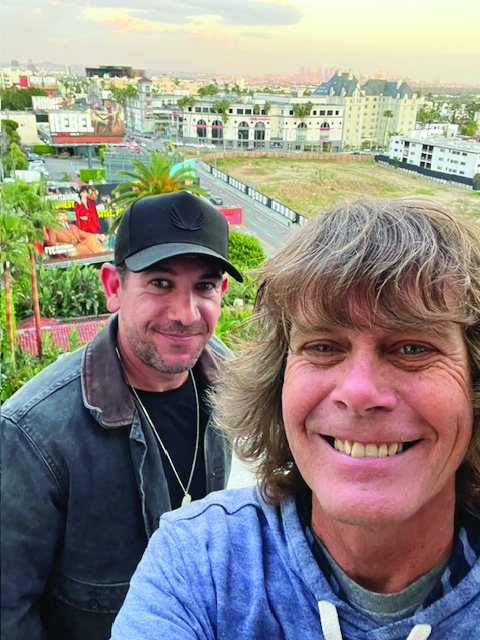
The Chateau Marmont’s penthouse balcony.
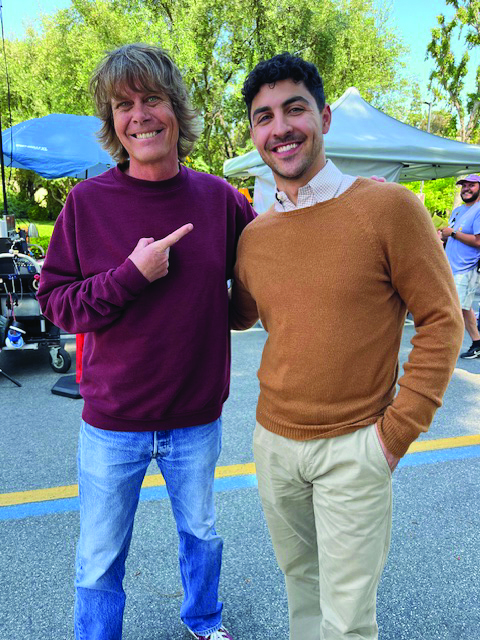
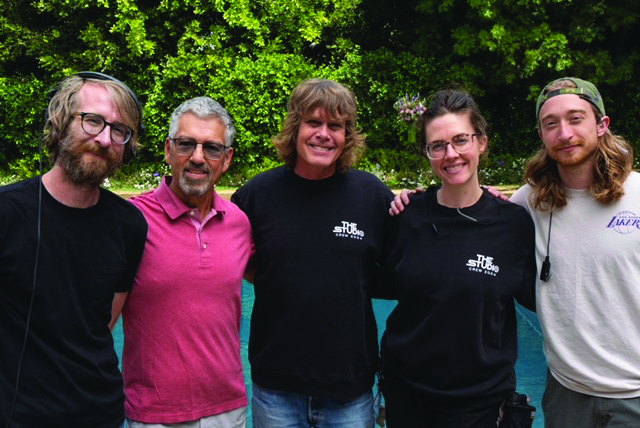
Buck Robinson CAS, Production Sound Mixer; Rachel Schroeder, Utility Sound Technician;
Evan Hare, Video Utility
This was going to be a fast-paced show, shot on the move. Long oners, golf cart chases across the lot, free-driving cars, you name it. The challenge was accepted.
My biggest concern right out of the gate was that my longtime Boom Operator Cole Bluma would not be available for large bits of the production schedule. As anyone who knows me can attest, Cole has been my knowledgeable and reliable right-hand man for many years.
While debating Cole’s replacement as primary Boom Operator, I called my friend Nick Allen. Nick is an accomplished Sound Mixer whose reputation in the sound community is second to none. He had done a ton of music playback and second unit mixing work for me previously, and we have a great rapport. We got together for coffee. I explained the show and its complexities, then I made my unorthodox pitch. I calculated that, at times, this gig might require two full sound carts or bag rigs or a playback cart, in any variety of combinations. I needed someone who was extremely versatile. Earlier in his career, Nick had a reputation as a top-notch Boom Operator on epic shows like Heat, The West Wing, and True Lies. Would he even entertain partnering with me on The Studio? After a few days of consideration, Nick jumped on as our primary Boom Operator, Second Unit Mixer, Playback Operator, and RF expert extraordinaire. Cole was available as our additional Boom Operator. We would also be backed by stellar Utility Sound Technicians in Rachel Schroeder and Kelsey Nie. We had our production sound crew!
Nick and I continued to analyze the scripts. The most unique aspect of the shooting style would be how we break the scenes up into big chunk one shots. Each individual camera shot propels the story forward in real time, connected occasionally by a whip pan stitch to another big chunk. As the sound department, we had to look at getting each scene right in the master. We needed to be as perfect as possible on every take, in case that was THE take for performance and camera. If they played it wide, that was it. If they were jumping to a moving vehicle and criss-crossing the Warner Bros. lot, we had to get it. The wires always had to be right. The gear had to work. RF signal flow would be critical. Between Nick and I, we knew we had all the gear. The trick would be how we implemented it.
From that first Zoom interview, we knew that good wires were a must. Thankfully, Evan and Seth value lavalier mics not only as backups to the boom, but as the primary line of attack, they sometimes need to be. Through reading the scripts and aware of the fluid camera movement that DP Adam Newport-Berra wanted to utilize, as well as dramatically wide vista shots at location, we understood that radio mics needed to be our most reliable weapons.
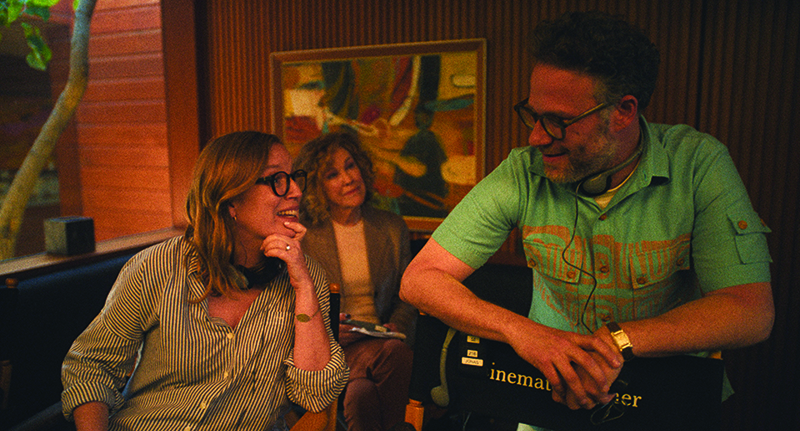
Our first step was establishing a line between our wiring experts Rachel Schroeder and Kelsey Nie, and our very talented costume department. I was delighted to learn that our Trailer Costumer Suzanne Block was someone I had worked with on the series The Affair. Our first rule of thumb was the mandate set by Seth. We should never have an actor arrive to set in a costume to then learn that the costume cannot be wired. Suzanne and the Set Costumers were instantly on board. Constant communication between Rachel, Kelsey, and the costume department would be essential. They were instrumental in bringing to our attention future costumes that might be problematic or need special preparation.
Despite everyone’s best efforts, one costume that could not be wired, landed on set in Episode 105, “The War.” That particular afternoon, we arrive at location, an interior scene in a small vintage townhouse in Hollywood, with a two-story living room and upstairs landing leading to a bedroom. We set up outside in the courtyard and Nick went inside to check out the apartment, returning less than five minutes later looking grim. The Grips already had a crane set up in the living room. Nick got a head’s up from the Grips and our friends in the camera department. Evan, and the DP Adam planned to shoot the scene with no coverage, in one fluid shot utilizing minimal whip pans to “stitch” multiple shots.
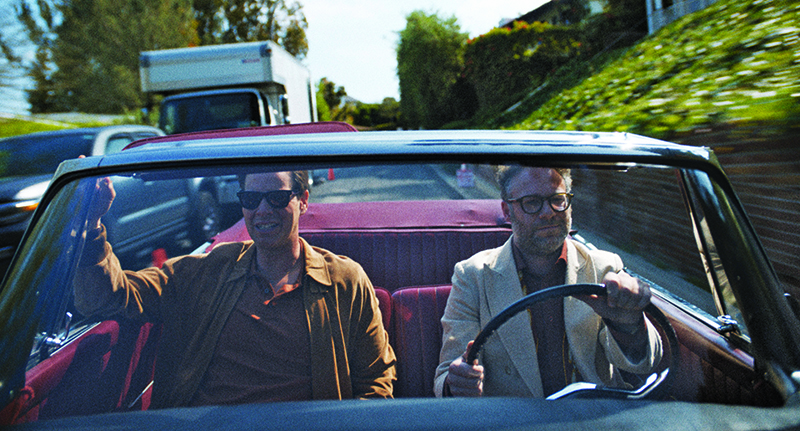
The action between Chase’s character Quinn and her boyfriend Miles starts with the couple in the throes of passion in Quinn’s bedroom. The camera then pulls back with her through a doorway to show Miles left sitting on the bed and Quinn now at the bathroom mirror. The boyfriend, then steps forward to her, and after a brief exchange at the bathroom door, the camera whips and lands on a crane arm, then drops with the actors as they proceed from the landing outside the bathroom down the stairs and through the apartment living space and kitchen. After a blocking rehearsal, one thing was clear, there would be very little that Nick could accomplish on the boom.
Here’s the kicker. Miles would not be wearing anything more than jockey briefs. The Costumers shared that per our directors, he would not be putting on a T-shirt either. I looked at Nick, it was time for a meeting with Seth and Evan.
We explained our concerns to them and let them know it was a radio mic shot. Although they were receptive, they were pretty adamant that they didn’t want the boyfriend wearing a shirt. In preparation for this very response, we offered a solution. What if Rachel gets together with the hair department and rigs a Countryman B6 into the actor’s shaggy hair, with the flesh tone lav run down the back of his neck to a Lectro SSM mic pack that’s stuck to the skin between his shoulder blades with Kinesiology tape? We realized from the blocking that he would be facing camera more than 90% of the time and the pack would be unseen. Our VFX crew led by Supervisor Sandro Blattner was phenomenal. How about they paint out the pack in the brief moment he faces away from camera outside the bathroom?
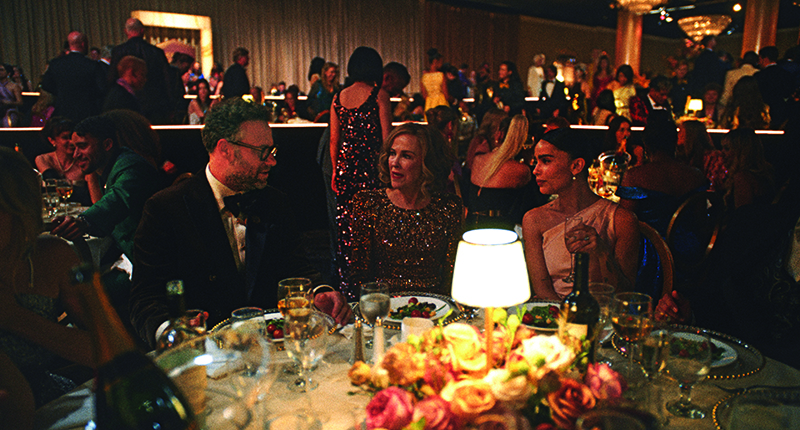
Zoe Kravitz at the Golden Globes
There was a long pause while the directors looked at each other, finally Evan shrugs, “Yeah, why not?” Seth nods his head, “Sure.” And that is my friends, how we wired the actor with the one costume that couldn’t be wired.
I honestly believe this illustrates a trait that makes Evan and Seth such successful filmmakers. They are willing to adapt to the needs of the crew who are working to achieve their vision. They are not afraid to hear suggestions and use all the tools at their disposal.
Our main concern when it came to reliable wireless would be proximity antenna placement and frequency coordination for lav mics, booms, IFB’s, Comteks, and camera coms, whether it be the friendly confines of our two-story office set on Stage 23 or out on location.
Fortunately, under the guidance of longtime Warner Bros. RF wizard Ara Mkhitaryan, we knew we would be in good hands with frequency coordination on the lot. Off the lot, unfortunately, we were not a part of the formal location scouts, but our veteran producers indulged in a very unique request, by allowing Nick to have “RF prep days” at a few select locations. He would travel to a chosen spot and dial in a frequency chart, and scout antenna placement, prior to landing on the shooting day. With little room for error, and the fast nature of shooting, any RF pre-calculations were invaluable.
We used a Ronin camera rig and there were shots planned where camera could start handheld, move to a golf cart or Grip Trix mount, travel across the lot, and become a “walk and talk” at a different location. Our crack “A” Camera Operator Mark Goellnicht, a tank of a man fresh off Mad Max: Fury Road, could either finesse or brute force the camera exactly where our directors and DP wanted it. Right off the bat, we realized that the big feature, yet documentary style, would yield a lot of opportunities for bag rig work as we would need to travel shoulder-to-shoulder with camera. We established our good rapport with Key Grip Adam Kolegas and crew to ensure there would always be a seat for us on the Grip Trix cart, or in a follow golf cart, ensuring close proximity to talent and camera. My rule of thumb was if Focus Puller Lucas Deans was in a moving vehicle, I should be seated next to him. The Grips were also instrumental in assisting the secure mounting of antennas to these moving rigs.
After we left the lot, the shots got even more complex. In Episode 104, “The Missing Reel,” on a night exterior scene in Hollywood, we started with the camera high up on a crane, as the camera then drops to the ground where it lands on the car on a “hostess tray” type side rig. Seth and Ike then whip a U-turn on Sunset Boulevard and end up parked on the opposite side of the street up the driveway of the Château Marmont. They then exit the car and continue inside the hotel entrance. In that shot, there was a redundant bag rig in the car while we were squirreled away with the sound cart at the top of the driveway in the side garage. Our Wisycom LFA antenna cables were remote one hundred and fifty feet from the driveway to the edge of Sunset Boulevard. These were split with Nick’s RF Venue Diversity Fin antenna on my cart. We were playing zone coverage with our receivers and recorders.
Sometimes these situations required a method I learned many years ago on a few reality TV stints, like The Osbournes and Top Chef: Masters. We called it “catch and release” whereas multiple bag rig mixers would all be receiving talent redundantly, on their individual rigs. This gave us the flexibility to stick with a specific camera operator but dial in different talent mics as they came and went in our camera zones. We implemented this strategy several times throughout the show; either carrying the actors with a bag rig to within the range of the cart or vice versa, mixing a scene on the cart and having the bag rig cover them as they travel. A notable example of this came when we filmed the now infamous “The Oner,” Episode 102.
Before I explain the technical side of the “The Oner,” it is imperative that I mention another collaboration that was paramount to our success on this location heavy series. Shooting at both “Silver Top,” the iconic John Lautner residence perched high above Silverlake, but also the other many breathtaking locations high in the hills. I’ve had the good fortune to do many shows with the transportation department, led by Keith Fisher and Captain Doug Weaver. Doug called me up two weeks before the show began to discuss load-in. We had come to realize on our past shows together that working from a Shorty 40 truck with liftgate was preferable to being in a trailer, as it could drop us right at the front door of many locations without skipping from a trailer to a stake bed, even if the Shorty 40 would have to be moved farther away during shooting. That would have utmost importance as we filmed at houses with tiny driveways, high above the city in the Hollywood Hills, miles from base camp.
Additionally, a great captain like Doug Weaver understands the significance of the pecking order as to who lands at set and when. This would never be more crucial than in The Studio. Not only were many of these locations very difficult to get in and out of, they were also chosen for their magnificent 360° views of the city. Once you got to these sleek mid-century modern houses of glass, there was very little room to hide anything. This was made all the more difficult by the shooting style, which dictated we would almost always eventually see everything.
Sometimes where you end up in or around a house can make or break your shooting day. It was especially true on “The Oner.” Over the course of the season, we pulled every trick, and favor up our sleeves to achieve a work spot at these locations. Transportation would get our sound and video truck up to the location in the first couple of runs. This would allow my team, and Local 695 Video Playback Operator Alfred Ainsworth Jr. and his assistant Evan Hare, to hit the ground right behind the camera department and get the layout of the land. Alfie and I would usually do a quick walkaround and formulate a plan for the sound cart, video playback cart, director’s monitor, and video village placement. I pride myself on good spatial awareness and knowing where things should be set up, but with his thirty-five-plus years in the film business, there seems no one better than Alfie Ainsworth at rapidly sussing out a plan for working a location. We were a good team.
Occasionally, I could gain key access to off-limit spaces through my relationships with our fantastic location department, led by Stacey Brashear-Rodriguez. Having worked many shows with us, they can trust and speak to my reliability to safeguard delicate spaces for the owner. At one house, our Dimmer Board Operator, Kyle Boorman, had the electric pre-rigging crew “hold” a spot for me next to his by staging gear there that would later go away upon our arrival. In mentioning the electricians, I must also point out the hyper-professional crew run by our talented Gaffer, Russell Ayer. I never had to look more than ten feet for power the entire show. They are Old School in their need to get to you before you’ve asked, stellar group top to bottom.
The episode setup of “The Oner” is familiar to every experienced film crew. Commonly known in our lingo, a “oner” is a camera move that carries the action through an entire scene with no edits or cutaways, in one individual shot. Famous examples can be found in films like Touch of Evil, Goodfellas, and Boogie Nights. Where our premise veers slightly are that our entire episode would be a oner (stitched occasionally) capturing our fictitious crew, filming this oner. To complicate matters, this would take place entirely in that little sliver of window approaching sunset, called “magic hour.”
Most of the location logistics and RF prep had been figured out ahead of time on one of Nick’s RF scouts. The use of editorial stitches would not only give the illusion of a complete oner for the episode but also allow us to break the work into three shooting days to keep the filming time of day in an acceptable few hours mimicking magic hour. The opportunity at stretching my definition of “catch and release” would happen right off the bat.
The episode opens with execs Matt and Sal driving and conversing, up winding streets through Silverlake in Matt’s convertible. At the culmination of the drive, the car stops parking outside the front door of the set in the “Silver Top” home’s driveway. At this point, our Camera Operator takes the camera from the car rig and carries our two actors, handheld as they exit the car, they are greeted by a PA, and lead inside the house to video village and meet with Director Sarah Polley, where the scene continues until a whip pan stitch.
To complicate the long driving part of the shot, the car would be free driving with no tow, lead, or pursuit vehicles, covering many blocks of streets leading to the house. Our real video village/command center would be hidden away inside the house for the entirety of the shot. We knew that we could zone cover the action by placing a bag rig in the convertible’s trunk to record the actors over the course of the long drive. As the car parks in the front driveway, the actors will come into range of my set antennas and I will be able to play the entire walk and talk, and video village portion from my cart.
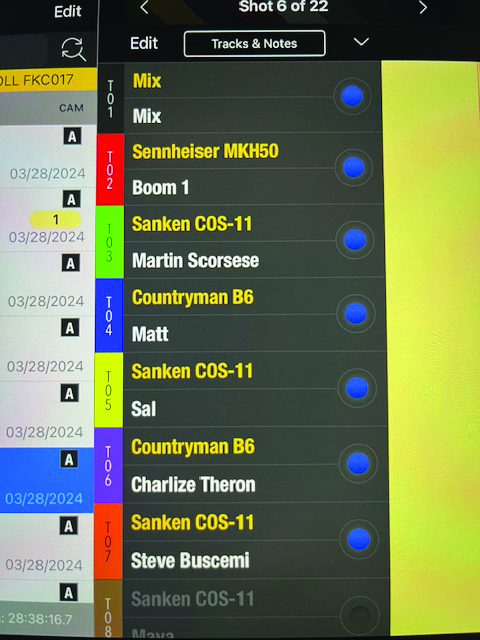
The puzzle to solve would be getting any kind of Comtek or IFB feed for the director’s village inside the house from the moving car, at such a great distance.
I conferred with Video Playback Operator Alfie and found out that he had been in contact with Greg “Noodles” Johnson, owner at RF Film Inc. If you work in Hollywood and need to get an RF signal from point A to point B, Noodles is the go-to guy. Alfie was planning to use Noodles’ long-range modified Wave Central transmitter system called a “PICO” to broadcast image from the car up to the house. I checked with his transmitter technician and Local 695 RF Operator Shan Siddiqi, and learned that the system was capable of transmitting embedded audio. We would therefore feed a mix track from the bag rig to the PICO transmitter mounted on the hero car. The transmitter would then send the picture and embedded audio to Shan’s receiver at set, at which point Alfie would pull his video signal for monitors, and I would pull the mix track audio signal to a channel on my Cooper CS208 mixing board. This allowed me to record the car driving dialog mix track simultaneously from the beginning of the take at my cart in the house, redundant to the bag rig recording in the car. It would also give me a clean signal for Comteks, IFB’s, and camera comms at the house from the start of the shot. It was one of the few instances where sound and image capture were truly working in sync. The system worked flawlessly and from the sound perspective was nearly fail-proof operationally. If the PICO signal dropped out, that part of the take would be no good for image and sound simultaneously at village. If it was bad for us, it was also bad for camera. Fortunately, a few test runs ironed out most of the kinks, and the entire system performed as intended on the day. After three days of filming, the company achieved what we set out to achieve, and “The Oner” was a great success.
I’d also like to mention Episode 108, “The Golden Globes,” as it was a stunning tribute, not only to Hollywood’s awards season, but to the technical abilities across the entire Local 695 community.
The producers wanted to closely mimic the actual look and feel of the Golden Globes. Our regular cast and incredible cameo stars would be working with all the elements of a real broadcast, with glorious lighting, massive video walls, live PA, and audience participation.
Much the same way that Sal Sapperstein became the star of the Golden Globes in our fictional universe, IATSE Local 695 crews were stars in the making of “The Golden Globes” episode.
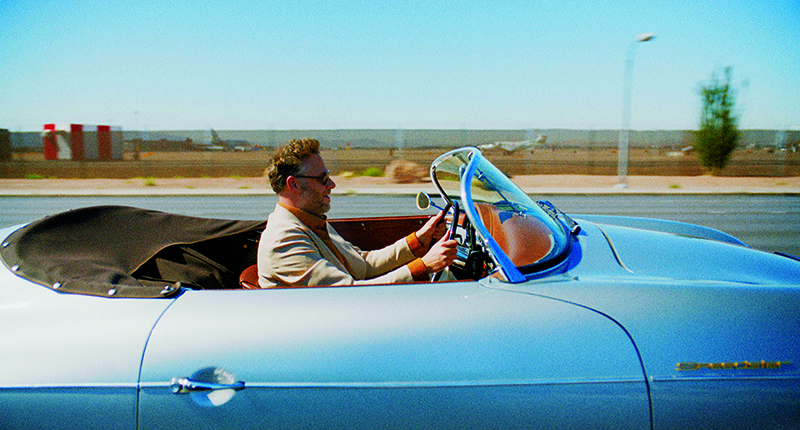
There was a great amount of 695 representation for a television series. In addition to our four-person sound crew and Alfie’s video playback and monitor crew, we had a 24-frame video/graphics playback team. Matt Brucell was Video Supervisor, Justin Edgerly and Justin White were the Video Engineers, with David Santos doing video playback for them.
This episode was filmed at the Beverly Hilton Hotel. We started with a limo arrival and grand entrance across the red carpet, into the hotel, and then through the lobby to the theater where our Golden Globes show would take place. Cole Bluma boomed the arrival lobby sequences, with me mixing, and Kelsey Nie filling the utility sound role. Nick Allen was inside the auditorium prepping the stage “Oscar Mic” and PA system for the following day’s work. The next few days, we moved into the auditorium and shot the actual award sequences. Nick boomed, Kelsey wired, and Cole operated the onstage “Oscar Mic” and PA system. Although our stage design didn’t allow for the telescoping stage mic that retracts into the floor, our esteemed Property Master Andrew Siegal was able to source the mic in a floor base model.
All the many elements came together beautifully in the end, and it was truly spectacular, loaded with pageantry. As was the entirety of The Studio; stolen moments at the Golden Globes, the search for a missing reel, a clandestine wrap party, or a fateful meeting with a director, the series spins a journey through the cinematic landscape and has been called Seth and Evan’s love letter to Hollywood. Getting to be part of a project that pays homage to our own work as filmmakers has been a fabulous opportunity. Being able to accomplish it with such fine professionals in every position was an absolute joy. We all look forward to more adventures in Season 2!